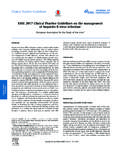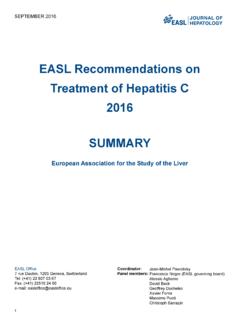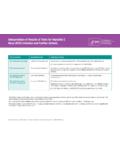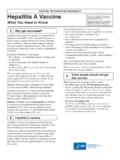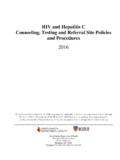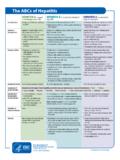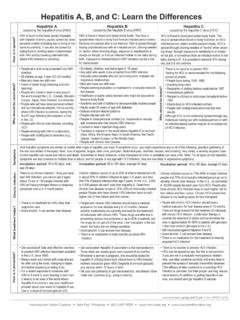Transcription of EASL Recommendations on Treatment of Hepatitis …
1 EASL Recommendations on Treatment of Hepatitis C 2016qEuropean Association for the Study of the Liver IntroductionHepatitis C virus (HCV) infection is one of the main causes ofchronic liver disease worldwide[1]. The long-term impact ofHCV infection is highly variable, ranging from minimal histolog-ical changes to extensive fibrosis and cirrhosis with or withouthepatocellular carcinoma (HCC). The number of chronicallyinfected persons worldwide is estimated to be about 180 million[2], but most are unaware of their infection. Clinical care forpatients with HCV-related liver disease has advanced consider-ably during the last two decades, thanks to an enhanced under-standing of the pathophysiology of the disease, and because ofdevelopments in diagnostic procedures and improvements intherapy and primary goal of HCV therapy is to cure the infection, toachieve a sustained virological response (SVR) defined asundetectable HCV RNA 12 weeks or 24 weeks after treatmentcompletion.
2 The infection is cured in more than 99% of patientswho achieve an SVR. An SVR is generally associated withnormalization of liver enzymes and improvement or disappear-ance of liver necroinflammation and fibrosis in patients withoutcirrhosis. Patients with severe liver disease remain at risk oflife-threatening complications; however hepatic fibrosis mayregress and the risk of complications such as hepatic failureand portal hypertension is reduced. Recent data suggest thatthe risk of HCC and all-cause mortality is significantly reduced,but not eliminated, in cirrhotic patients who clear HCV comparedto untreated patients and non-sustained virological responders[3 5]. HCV is also associated with a number of extrahepaticmanifestations and effective viral suppression induces reversalof most of them[6].
3 These EASL Recommendations on Treatment of Hepatitis C areintended to assist physicians and other healthcare providers, aswell as patients and other interested individuals, in the clinicaldecision-making process by describing the current optimal man-agement of patients with acute and chronic HCV infections. Theserecommendations apply to therapies that have been approved bythe European Medicines Agency and other national Europeanagencies at the time of their EASL Recommendations have been prepared by a panel ofexperts chosen by the EASL Governing Board. The recommenda-tions were approved by the EASL Governing Board. The recom-mendations have been based as far as possible on evidencefrom existing publications and presentations at internationalmeetings, and, if evidence was unavailable, the experts personalexperiences and opinion.
4 Wherever possible, the level of evidenceand recommendation are cited. The evidence and recommenda-tions have been graded according to the Grading of Recommen-dations Assessment, Development and Evaluation (GRADE)system. The strength of Recommendations thus reflects the qual-ity of underlying evidence. The principles of the GRADE systemhave been enunciated[7]. The quality of the evidence in the rec-ommendations has been classified into one of three levels: high(A), moderate (B) or low (C). The GRADE system offers two gradesof recommendation: strong (1) or weak (2) (Table 1). The recom-mendations thus consider the quality of evidence: the higher thequality of evidence, the more likely a strong recommendation iswarranted; the greater the variability in values and preferences,or the greater the uncertainty, the more likely a weaker recom-mendation is Recommendations are necessarily based on currentlylicensed drugs.
5 They will be updated regularly, followingapproval of new drug regimens by the European MedicinesAgency and other national European of acute and chronic Hepatitis CThe diagnosis of acute and chronic HCV infection is based on thedetectionofHCVRNA byasensitivemolecularmethod(lowerlimitof detection615 international units [IU]/ml). Anti-HCV antibodiesare detectable by enzyme immunoassay (EIA) in the vast majorityof patients with HCV infection, but EIA results may be negative inearly acute Hepatitis C and in profoundly immunosuppressedpatients. Following spontaneous or Treatment -induced viral clear-ance, anti-HCV antibodies persist in the absence of HCV RNA butmay decline and finally disappear in some individuals[8,9].The diagnosis of acute Hepatitis C can be confidently madeonly if seroconversion to anti-HCV antibodies can be docu-mented, since there is no serological marker which proves thatHCV infection is in thede novoacquired acute phase.
6 Not allpatients with acute Hepatitis C will be anti-HCV positive at diag-nosis. In these cases, acute Hepatitis C can be suspected if theclinical signs and symptoms are compatible with acute Hepatitis (alanine aminotransferase [ALT] >10 times the upper limit ofnormal, and jaundice) in the absence of a history of chronic liverdisease or other causes of acute Hepatitis , and/or if a likely recentJournal of Hepatology2016vol. xxxjxxx xxxReceived 9 September 2016; accepted 9 September 2016qCoordinator:Jean-Michel Pawlotsky;Panel members:Alessio Aghemo, DavidBack, Geoffrey Dusheiko, Xavier Forns, Francesco Negro, Massimo Puoti,Christoph Sarrazin. Correspondence: EASL Office, 7 rue Daubin, CH 1203 Geneva, Switzerland. Tel.:+41 22 807 0360; fax: +41 22 328 cite this article in press as.
7 EASL Recommendations on Treatment of Hepatitis C 2016. J Hepatol (2016), of transmission is identifiable. In all cases, HCV RNA canbe detected during the acute phase although brief interludes ofundetectable HCV RNA may reinfection has been described after spontaneous ortreatment-induced HCV clearance, essentially in patients athigh-risk of infection. Reinfection is defined by the reappearanceof HCV RNA at least 6 months after an SVR and the demonstrationthat infection is due to a different HCV strain (different genotypeor distantly related strain by phylogenetic analysis if the geno-type is the same).The diagnosis of chronic Hepatitis C is based on the detectionof both anti-HCV antibodies and HCV RNA in the presence of bio-logical or histological signs of chronic Hepatitis .
8 Since, in the caseof a newly acquired HCV infection, spontaneous viral clearance isvery rare beyond 4 to 6 months of infection[10], the diagnosis ofchronic Hepatitis C can be made after that time core antigen is a surrogate marker of HCV antigen detection can be used instead of HCV RNA detectionto diagnose acute or chronic HCV infection. HCV core antigenassays are less sensitive than HCV RNA assays (lower limit ofdetection equivalent to approximately 500 to 3000 HCV RNAIU/ml, depending on the HCV genotype[11,12]). As a result,HCV core antigen becomes detectable in peripheral blood a fewdays after HCV RNA in patients with acute Hepatitis C. In rarecases, core antigen is undetectable in the presence of HCV Anti-HCV antibodies are the first line diagnostic test for HCV infection (A1).
9 In the case of suspected acute Hepatitis C or in immunocompromised patients, HCV RNA testing should be part of the initial evaluation (A1). If anti-HCV antibodies are detected, HCV RNA should be determined by a sensitive molecular method (A1). Anti-HCV positive, HCV RNA-negative individuals should be retested for HCV RNA 3 months later to confirm definitive clearance (A1). HCV core antigen is a surrogate marker of HCV replication and can be used instead of HCV RNA to diagnose acute or chronic infection when HCV RNA assays are not available or not affordable (core antigen assays are slightly less sensitive than HCV RNA assays for detection of viral replication) (A1).Screening for chronic Hepatitis CA major barrier to HCV elimination still results from the factthat a substantial proportion of patients with chronic hepatitisC are unaware of their infection, with large variations acrossthe different regions/countries.
10 In addition, accurate HCVprevalence and incidence data are needed to analyse themagnitude of the pandemic in different regions and to designpublic health interventions. Thus, Hepatitis C testing is requiredto identify infected persons and engage them in care and treat-ment, and screening for markers of HCV infection must screening strategies have been implemented indifferent regions, based on the local epidemiology. Groupsat higher risk of HCV infection can be identified and shouldbe tested. In regions where the majority of patients belongto a well-defined age group, birth cohort testing proved effi-cacious, with limitations[13,14]. Systematic one-time testinghas been recommended in countries with high endemicityand/or a goal of complete eradication.
